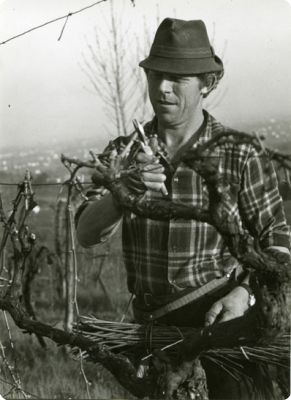HISTORICAL PROFILE OF THE VESPAIOLO

The vine in Vicenza seems to originate in the tertiary Era; In particular in the Alto Vicentino were found in Salcedo, along the river Chiavone, finds of the first Vitaceae attributed to the genus of ampelophyllum. The middle of the last century A. B. Massalongo classified the fossil imprint of a grape cluster and a vine leaf. It is therefore probable that these Vinaceae (Ampelophyllum) gave rise, after the glaciations, to spontaneous and wild vines and from these to the Vitis vinifera.
A Viticultural event important for the Vicentina province happened at the end in 1200 where in Vicenza, on the initiative of the Podesteria Vicentina, the deforestation in favour of the vine was decreed. In the meantime,1295, in Bassano (town disputed for more than one hundred years between Padua and Vicenza), a wine code was drafted, code “Vineale” or “Vignale or statutes of Bassano, which is the precursor of what today could be called” disciplinary of Production “. The code consists of 345 articles, many of which concern the grape harvest, the vinification, the denunciation of the grapes and the wine and some special provisions are reserved for white wine that requires a permit for the sale, for this subject to very strict controls. In this period the vine is generally cultivated “low” in the hills and the wines are predominantly white with high gradation, while in the plain it is cultivated “high” leaning against live or dead supports and the wines are red.
In the first years of the fifteenth century, the Serenissima Republic of Venice conquered the Veneto and with it the Alto Vicentino, modifying the landscape of the mainland, we built the first villas around which is articulated an efficient farm. The Vicentino river routes are enhanced to facilitate the arrival of wine in Venice, and the Vicentine landed nobility obtains protection, privileges and duty exemption from the Government of Venice. In this historical period, the Vespaiolo also enters into tales of the events of the time. It is recalled that when Charles V, young and handsome king, went down to Italy from Austria to meet with Pope Clement VII in Bologna, he stayed at Sandrigo where, guest of Cassandra degli Arnaldi, widow of Bernardino Sesso, obtained as a gift a considerable number of barrels of Bresparolo wine.
In 1610 Andrea Scotto in his “itinerary”, praises the Vicentina wine production and mentions Breganze “famous for its sweet and savory wines” in another interesting publication of the 1754, “Il Roccolo”, Aureliano Acanti writes in tones enthusiastically Convinced and complacent that “over everything, without a hesitation, I assert there is no other province (only one city I mean, and of a single countryside) that many species, and yes various, and yes different, and so delicate of wines produce, how many produce our own.” In this poetic work that represents a kind of oenological guide of the province of Vicenza, thirty five wines produced in the Vicentino and Breganze appear three times. “… you are titillations with that grateful Vespaiolo Breganzino, that in my opinion of man Togato is better than any other wine…” Continue then in footnotes explaining that someone also does withered “… and is one of the most excellent liqueurs, is really tasty.”
The nineteenth century is the centuries of radical changes for Vicentina viticulture: Many vines disappear and are replaced by others from France.
In 1855 in Vicenza, on the occasion of the first “exhibition of primitive soil Products”, a catalogue is made that lists 120 varieties and red grape grapes and 77 white berries where the Vespaiola or Bresparola also appears as an on-site call. The Vespaiola grape is called so because its juice is particularly loved by the wasps. The vine is of unknown origin, perhaps southern (as attested in an ampelographic bulletin printed in Rome in 1881 where it was given the origin in Bucchianico locality of Vespaolora), perhaps French (as quoted in the volume “Principes de la plantation et de la Culture du Chasselas et l’autre vignes précoces “published in Paris in 1811 where he quoted the “Vesparol qui n’est pas moins sucré et que les guèpes on dévoré long-temps avant les vendanges, aussi on néglige de le cultiver dans ce pays, parce qu’il ne va jamais à la cave”) , certainly imported to Breganze by the nobles of Vicenza to satisfy the tastes of the Venetians in their sojourns in the Vicentine Villas.
The historical testimonies of the Vespaiolo in the 800 are scarce perhaps because of the same vespas that damaging the harvest make cultivation unprofitable. The spread of the vine is also stopped at the beginning of 900 due to the phylloxera and the task of the World Wars.
In fact, after the Second World War, because of the damage brought to the vineyards, begins, for the area of Breganze a new wine-growing phase, stimulating also the planting of rooted of vespaiolo.
In 1969 with the DPR on July 18 the first denomination of origin controlled for the province of Vicenza makes its entrance: “Breganze”, recognizing as DOC wines “Breganze Rosso”, “Breganze Cabernet”, “Breganze Pinot Nero”, “Breganze Bianco”, “Breganze Pinot Bianco” and ” Breganze Vespaiolo “, (Official Journal of 4.9.1969).
The Vespaiola is a white grape variety that has a fairly long vegetative cycle and which matures in the last ten days of September; It needs a long pruning since the buds of the first gems are not fertile. It loves the hilly terrain of volcanic origin and the gravel, placed in sunny and airy sites. The wine, which presents an interesting predisposition to ageing, has a straw color with greenish reflections in its youth, a scent of good intensity, elegant and non-aggressive, with floral and fruity scents such as acacia and citrus fruit to evolve into Quince, almond and pleasing mineral notes with refinement. In the mouth presents an enviable freshness for the presents of a natural acidity, which makes it suitable for demanding dishes, even fat and greasy.
In Vicenza it is traditionally married with asparagus in the Bassanese and the Cod alla Vicentina, but just as well it accompanies dishes of fish also raw.


